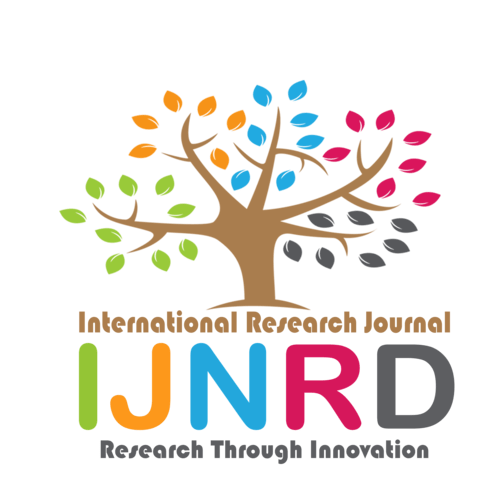|
|||||||||||||||

|
INTERNATIONAL JOURNAL OF NOVEL RESEARCH AND DEVELOPMENT International Peer Reviewed & Refereed Journals, Open Access Journal ISSN Approved Journal No: 2456-4184 | Impact factor: 8.76 | ESTD Year: 2016 Scholarly open access journals, Peer-reviewed, and Refereed Journals, Impact factor 8.76 (Calculate by google scholar and Semantic Scholar | AI-Powered Research Tool) , Multidisciplinary, Monthly, Indexing in all major database & Metadata, Citation Generator, Digital Object Identifier(DOI) |
||||||||||||||
Issue: April 2024
Volume 9 | Issue 4
Review Result and Publication of Paper within : 2-3 days
Click Here For more DetailsFor Authors
Forms / Download
Published Issue Details
Editorial Board
Other IMP Links
Facts & Figure
Impact Factor : 8.76
Issue per Year : 12
Volume Published : 9
Issue Published : 95
Article Submitted :
Article Published :
Total Authors :
Total Reviewer :
Total Countries :
Indexing Partner
Join RMS/Earn 300
Licence
This work is licensed under a Creative Commons Attribution-NonCommercial 4.0 International License







|
Published Paper Details
|
|
| Paper Title: | A review on Pharmacological and Phytochemical properties of Luffa echinata |
| Authors Name: | Sonal H. Kanani , Dr. Devang J Pandya |
| Download E-Certificate: | Download |
| Author Reg. ID: |
IJNRD_184734
|
| Published Paper Id: | IJNRD2303001 |
| Published In: | Volume 8 Issue 3, March-2023 |
| DOI: | |
| Abstract: | Background: Plants are the source of a variety of important secondary metabolites with pharmacological and pharmacognostic consequences that have the potential to become future "super medicines." The biotic and abiotic stressors have an impact on how these metabolites are produced in vivo, which causes a steady build-up of different phytochemicals. and their derivatives, which can help create and develop future medications. The current study's goal is to review the occurrence of potentially useful pharmacological and pharmacognostic secondary metabolites considering the possible uses of the understudied Ayurvedic medicinal plant species Luffa echinata inventing and creating pharmaceuticals for the future. Main body of the abstract: Luffa echinata, a member of the Cucurbitaceae family, is a rich source of phytochemicals for therapeutic use, including Cucurbitacine B, Cucurbitacine E, Eletarin-2-glycoside, Beta-sterol glycoside, Chrysirol, Echinatin, Apigenin, Luteolin, Luteolin-7-glycoside, Datiscacin, Oleanolic acid. These substances all or some of which have anti-cancer, antioxidant, antimicrobial, antibacterial, antiviral, analgesic, anti-inflammatory, antidepressant, anxiolytic, antiepileptic, hepatoprotective, antifungal, and antiulcer activity. Short Conclusion: alkaloids, carbohydrates, proteins, glycosides, flavonoids, sterols, triterpenes, flavones, reducing sugars, and tannins. Potent bioactive compounds like CuB, eletarin (CuE), eletarin-2-glucoside, isocucurbitacin B, β-sitosterol, echinatol-A, and -B, chrysirol-7-glucoside, chrysirol-7-epiglucoside, echinatol A, echinatol B, echinatin have been reported from the fruits. Datiscacin (cucurbitin-20-acetate) found in Luffa echinata that have the potential to replace conventional drugs as therapeutic agents. Its uses may be attributed to important classes of phytochemicals present in it; a bitter compound known to have antitumor activity has been reported from L. echinata. Similarly, flavonoids (luteolin-7-glucoside and chrysoeriol-7-glucoside), triterpenes, fatty acids, and saponin (gypsogennin) have been also isolated from seeds. The present chapter gives a detailed review of Luffa echinata chiefly from its pharmacognostic, phytochemical, and utility perspectives. |
| Keywords: | Devadali, Cytotoxic, Cucurbitacine, Cucurbitaceae, TNBC, Pharmacological |
| Cite Article: | "A review on Pharmacological and Phytochemical properties of Luffa echinata ", International Journal of Novel Research and Development (www.ijnrd.org), ISSN:2456-4184, Vol.8, Issue 3, page no.a1-a11, March-2023, Available :http://www.ijnrd.org/papers/IJNRD2303001.pdf |
| Downloads: | 000118755 |
| ISSN: |
2456-4184 | IMPACT FACTOR: 8.76 Calculated By Google Scholar| ESTD YEAR: 2016 An International Scholarly Open Access Journal, Peer-Reviewed, Refereed Journal Impact Factor 8.76 Calculate by Google Scholar and Semantic Scholar | AI-Powered Research Tool, Multidisciplinary, Monthly, Multilanguage Journal Indexing in All Major Database & Metadata, Citation Generator |
| Publication Details: |
Published Paper ID:IJNRD2303001 Registration ID: 184734 Published In: Volume 8 Issue 3, March-2023 DOI (Digital Object Identifier): Page No: a1-a11 Country: Rajkot, GUJARAT, INDIA Research Area: Pharmacy Publisher : IJ Publication Published Paper URL : https://www.ijnrd.org/viewpaperforall?paper=IJNRD2303001 Published Paper PDF: https://www.ijnrd.org/papers/IJNRD2303001 |
| Share Article: | |
|
Click Here to Download This Article |
|
| Article Preview | |
|
|
|
Major Indexing from www.ijnrd.org
| Semantic Scholar | Microsaoft Academic | ORCID | Zenodo |
| Google Scholar | ResearcherID Thomson Reuters | Mendeley : reference manager | Academia.edu |
| arXiv.org : cornell university library | Research Gate | CiteSeerX | PUBLON |
| DRJI | SSRN | Scribd | DocStoc |
ISSN Details
 |
 |
ISSN: 2456-4184
Impact Factor: 8.76 and ISSN APPROVED
Journal Starting Year (ESTD) : 2016
DOI (A digital object identifier)
Conference
Open Access License Policy
Important Details
Social Media
| Copyright © 2024 - All Rights Reserved - IJNRD |












Facebook Twitter Instagram LinkedIn